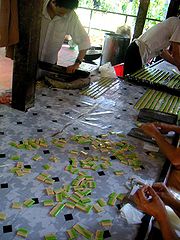
Coconut candy
Encyclopedia


Ben Tre Province
Bến Tre is a province of Vietnam. It is one of the country's southern provinces, being situated in the delta of the Mekong River.-Administration:Politically, Ben Tre is divided into eight districts:*Ba Tri*Bình Đại*Châu Thành*Chợ Lách*Giồng Trôm...
, Vietnam
Vietnam
Vietnam – sometimes spelled Viet Nam , officially the Socialist Republic of Vietnam – is the easternmost country on the Indochina Peninsula in Southeast Asia. It is bordered by China to the north, Laos to the northwest, Cambodia to the southwest, and the South China Sea –...
, made with coconut milk
Coconut milk
Coconut milk is the water that comes from the grated meat of a coconut. The colour and rich taste of the milk can be attributed to the high oil content. In many parts of the world, the term coconut milk is also used to refer to coconut water, the naturally occurring liquid found inside the hollow...
and coconut cream
Coconut cream
Coconut cream is very similar to coconut milk but contains less water. The difference is mainly consistency. It has a thicker, more paste-like consistency, while coconut milk is generally a liquid...
. The Ben Tre Province is nicknamed by Vietnamese as the "Land of Coconut" (Xu Dua). The Vietnamese term for coconut candy is "kẹo dừa", with kẹo = candy and dừa = coconut. Coconut candy was originally associated with Mo Cay, a small township within the Ben Tre province.
Manufacturing process
The production of coconut candy starts with the grating of fresh coconut flesh. The grated flesh is then pressed to extract coconut milk and coconut cream. The next step is the addition of malt syrup and sugar to this mixture of coconut milk and cream. The ratio of the various ingredients is a closely guarded secret of individual coconut candy manufacturers. The mixing process is often entrusted only to family members of the factory owner. Slight variations in the ingredient ratios can lead to very different texture and taste in the final product.The mixture is then heated to a very high temperature in large woks over fires generated by the burning of coconut shells. While being heated, the mixture is stirred continuously to ensure even heat distribution. Traditionally, this stirring process was done manually with large wooden paddles. In larger modern manufacturing facilities, these paddles have been replaced by electric motors. The mixture eventually caramelises to a thicker texture. Recognising when the mixture has been cooked to the right level is more of an art than an exact science. While it is still hot and soft, the thickened mixture is then stringed out into moulds and allowed to cool. The final step sees the candy strings cut into rectangular lozenges, then wrapped and packaged.
Traditionally, coconut candy is wrapped in two layers of wrappings. The inner layer is edible rice paper, and the outer layer is paper soaked in vegetable oil. These measures were necessary to stop the candy from sticking to the paper wrapping. Larger manufacturers now use heat-sealed foil paper, which does not stick to the candy.
Economic Importance
Ben Tre currently has over one hundred coconut candy manufacturers, making up thirty percent of local enterprises. However, the market is dominated by a handful of well known brands, with most manufacturers producing candy under licence for these brands. Coconut candy is sold throughout Vietnam. It is also exported to other Asian countries, AustraliaAustralia
Australia , officially the Commonwealth of Australia, is a country in the Southern Hemisphere comprising the mainland of the Australian continent, the island of Tasmania, and numerous smaller islands in the Indian and Pacific Oceans. It is the world's sixth-largest country by total area...
, Europe
Europe
Europe is, by convention, one of the world's seven continents. Comprising the westernmost peninsula of Eurasia, Europe is generally 'divided' from Asia to its east by the watershed divides of the Ural and Caucasus Mountains, the Ural River, the Caspian and Black Seas, and the waterways connecting...
and North America
North America
North America is a continent wholly within the Northern Hemisphere and almost wholly within the Western Hemisphere. It is also considered a northern subcontinent of the Americas...
.

